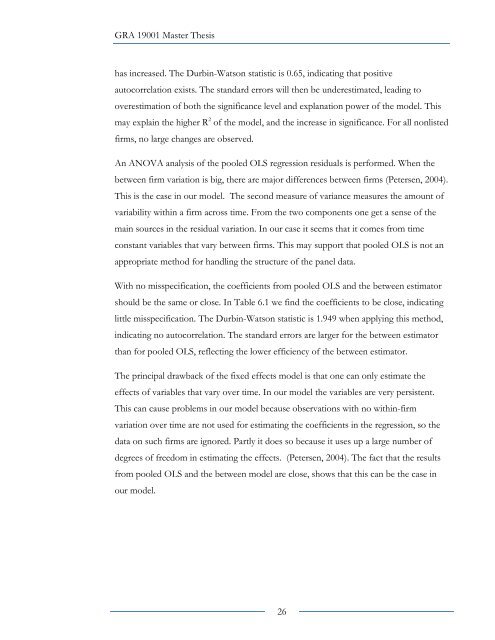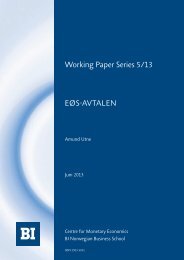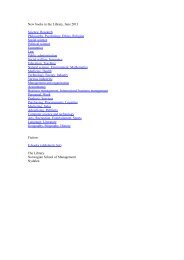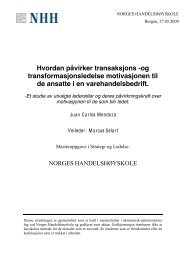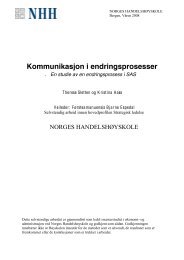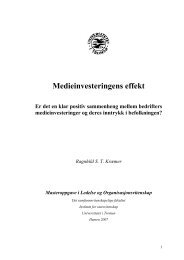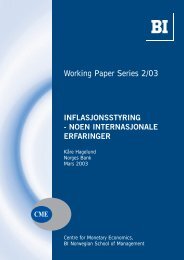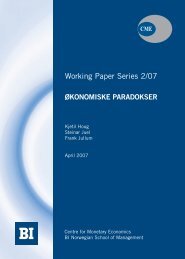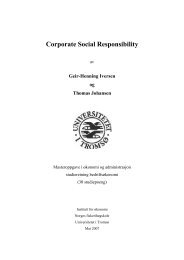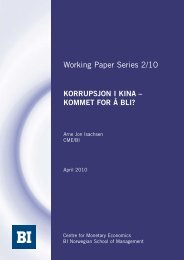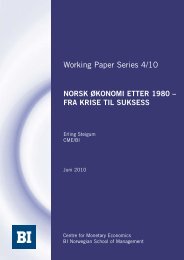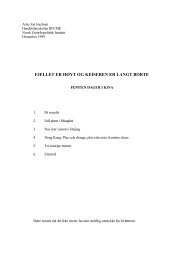Gender Diversity on the Board - BI Norwegian Business School
Gender Diversity on the Board - BI Norwegian Business School
Gender Diversity on the Board - BI Norwegian Business School
You also want an ePaper? Increase the reach of your titles
YUMPU automatically turns print PDFs into web optimized ePapers that Google loves.
GRA 19001 Master Thesis<br />
has increased. The Durbin-Wats<strong>on</strong> statistic is 0.65, indicating that positive<br />
autocorrelati<strong>on</strong> exists. The standard errors will <strong>the</strong>n be underestimated, leading to<br />
overestimati<strong>on</strong> of both <strong>the</strong> significance level and explanati<strong>on</strong> power of <strong>the</strong> model. This<br />
may explain <strong>the</strong> higher R 2 of <strong>the</strong> model, and <strong>the</strong> increase in significance. For all n<strong>on</strong>listed<br />
firms, no large changes are observed.<br />
An ANOVA analysis of <strong>the</strong> pooled OLS regressi<strong>on</strong> residuals is performed. When <strong>the</strong><br />
between firm variati<strong>on</strong> is big, <strong>the</strong>re are major differences between firms (Petersen, 2004).<br />
This is <strong>the</strong> case in our model. The sec<strong>on</strong>d measure of variance measures <strong>the</strong> amount of<br />
variability within a firm across time. From <strong>the</strong> two comp<strong>on</strong>ents <strong>on</strong>e get a sense of <strong>the</strong><br />
main sources in <strong>the</strong> residual variati<strong>on</strong>. In our case it seems that it comes from time<br />
c<strong>on</strong>stant variables that vary between firms. This may support that pooled OLS is not an<br />
appropriate method for handling <strong>the</strong> structure of <strong>the</strong> panel data.<br />
With no misspecificati<strong>on</strong>, <strong>the</strong> coefficients from pooled OLS and <strong>the</strong> between estimator<br />
should be <strong>the</strong> same or close. In Table 6.1 we find <strong>the</strong> coefficients to be close, indicating<br />
little misspecificati<strong>on</strong>. The Durbin-Wats<strong>on</strong> statistic is 1.949 when applying this method,<br />
indicating no autocorrelati<strong>on</strong>. The standard errors are larger for <strong>the</strong> between estimator<br />
than for pooled OLS, reflecting <strong>the</strong> lower efficiency of <strong>the</strong> between estimator.<br />
The principal drawback of <strong>the</strong> fixed effects model is that <strong>on</strong>e can <strong>on</strong>ly estimate <strong>the</strong><br />
effects of variables that vary over time. In our model <strong>the</strong> variables are very persistent.<br />
This can cause problems in our model because observati<strong>on</strong>s with no within-firm<br />
variati<strong>on</strong> over time are not used for estimating <strong>the</strong> coefficients in <strong>the</strong> regressi<strong>on</strong>, so <strong>the</strong><br />
data <strong>on</strong> such firms are ignored. Partly it does so because it uses up a large number of<br />
degrees of freedom in estimating <strong>the</strong> effects. (Petersen, 2004). The fact that <strong>the</strong> results<br />
from pooled OLS and <strong>the</strong> between model are close, shows that this can be <strong>the</strong> case in<br />
our model.<br />
26


